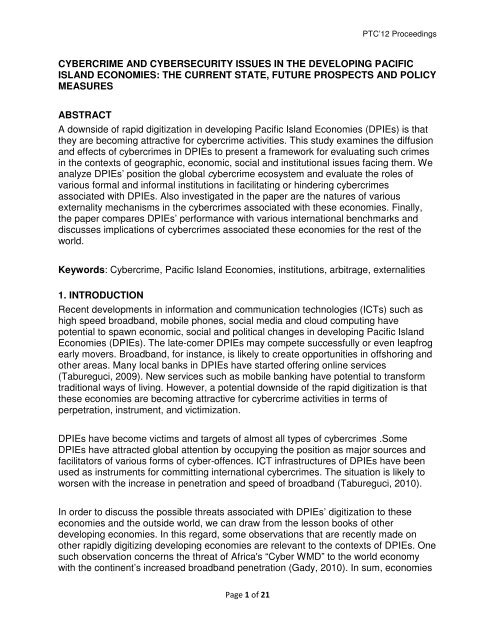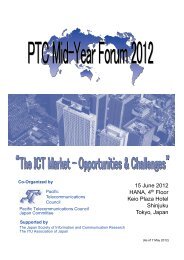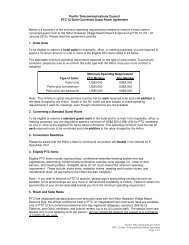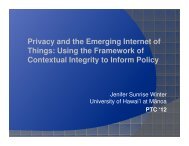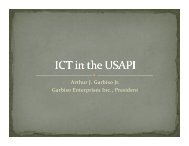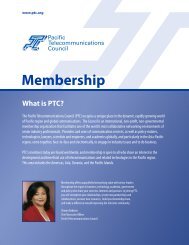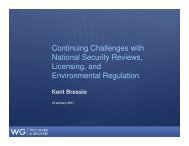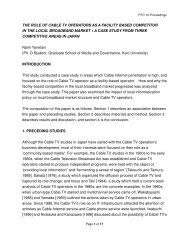cybercrime and cybersecurity issues in the developing pacific
cybercrime and cybersecurity issues in the developing pacific
cybercrime and cybersecurity issues in the developing pacific
You also want an ePaper? Increase the reach of your titles
YUMPU automatically turns print PDFs into web optimized ePapers that Google loves.
PTC’12 Proceed<strong>in</strong>gsThere are also <strong>in</strong>stances <strong>in</strong> which DPIEs are used by <strong>in</strong>ternational cybercrim<strong>in</strong>als tolaunder <strong>cybercrime</strong> proceeds. In one such example, cybercrim<strong>in</strong>als stole more than$685,000 from <strong>the</strong> superannuation fund of 121 <strong>in</strong>dividuals <strong>in</strong> Australia. The fund wastransferred to <strong>the</strong> Philipp<strong>in</strong>es <strong>and</strong> some DPIEs us<strong>in</strong>g low-value <strong>in</strong>ternational fundstransfers (Fife-Yeomans, 2011). In ano<strong>the</strong>r case, cyber Crime Investigations Unit of Fijipolice reported that three people <strong>in</strong> Fiji were work<strong>in</strong>g <strong>in</strong> partnership with foreignnationals to launder money by us<strong>in</strong>g Fiji as a transit po<strong>in</strong>t (Scheiche, 2011). The Fijiresidents were recruited through popular social network<strong>in</strong>g sites.3. A FRAMEWORK FOR EXPLAINING CYBERCRIMES ASSOCIATED WITH DPIES3.1. INSTITUTIONS RELATED TO CYBERCRIMES IN DPIESThe nature of activities of cyber-crim<strong>in</strong>als fits squarely with what Baumol (1990) callsdestructive entrepreneurship. Baumol (1990) hypo<strong>the</strong>sized that <strong>the</strong> distribution ofproductive, unproductive, <strong>and</strong> destructive entrepreneurs <strong>in</strong> a society is a function of <strong>the</strong>“relative payoffs” offered to <strong>the</strong>se activities by <strong>the</strong> society’s “rules of <strong>the</strong> game”. Theserules are also referred as formal <strong>and</strong> <strong>in</strong>formal <strong>in</strong>stitutions, which embed economicactivities <strong>and</strong> actors (Granovetter, 1985; North, 1990; Parto, 2005). These <strong>in</strong>stitutions <strong>in</strong><strong>the</strong> context of DPIEs’ <strong>cybercrime</strong> l<strong>and</strong>scape are discussed below.3.1.2. Formal <strong>in</strong>stitutionsDPIEs are characterized by weak formal <strong>in</strong>stitutions aga<strong>in</strong>st <strong>cybercrime</strong>s. They lagbeh<strong>in</strong>d <strong>the</strong> curve <strong>in</strong> enact<strong>in</strong>g <strong>and</strong> enforc<strong>in</strong>g <strong>cybercrime</strong> related regulative laws <strong>and</strong> havevery little legislation specific to <strong>cybercrime</strong> <strong>and</strong> cyber-security (Ahmadu, 2006; Angelo,2009). In many DPIEs, hack<strong>in</strong>g someone’s computer over a network connection is notyet considered as a crime. The most often cited case was that of an expatriate <strong>in</strong> 2008,who went to Fiji <strong>and</strong> engaged <strong>in</strong> a number of <strong>cybercrime</strong> activities with impunity. Heaccessed local firms’ networks <strong>in</strong> an unauthorized manner (Tabureguci, 2010).While some have enacted <strong>cybercrime</strong> laws, <strong>the</strong>y have little capacity to enforce <strong>the</strong>m.Accord<strong>in</strong>g to <strong>the</strong> Pacific Isl<strong>and</strong>s computer crime & security survey <strong>in</strong> 2008, perpetratorswere charged with an offence only <strong>in</strong> 5% of <strong>the</strong> reported cases. Factors such as<strong>in</strong>adequate legislation, <strong>in</strong>sufficient evidence <strong>and</strong> <strong>in</strong>ternational jurisdictional <strong>issues</strong> wereamong <strong>the</strong> most critical barriers to act on <strong>the</strong> reported cases (Phair, 2008). SiaosiSovaleni, a manager at <strong>the</strong> ICT Outreach Program of Secretariat of <strong>the</strong> PacificCommunity (SPC) under <strong>the</strong> Economic Development Division recently put <strong>the</strong> issue thisway: “Measures <strong>in</strong>clude crim<strong>in</strong>al law <strong>and</strong> crim<strong>in</strong>al justice action. Currently, most isl<strong>and</strong>states of <strong>the</strong> Pacific region are not sufficiently equipped to protect <strong>the</strong>ir societies aga<strong>in</strong>st<strong>cybercrime</strong> through crim<strong>in</strong>al law, nor are <strong>the</strong>y are <strong>in</strong> a position to engage <strong>in</strong> efficient<strong>in</strong>ternational cooperation <strong>in</strong> this respect" (MIC, 2011).3.1.2. INFORMAL INSTITUTIONSThere has been a low level of awareness among governments, bus<strong>in</strong>esses <strong>and</strong>consumers about <strong>cybercrime</strong>s <strong>and</strong> protection measures. One expert noted: “It(awareness) is still pretty low, as most enforc<strong>in</strong>g agencies <strong>and</strong> legal agencies are notPage 6 of 21
PTC’12 Proceed<strong>in</strong>gsaware of <strong>the</strong> <strong>issues</strong>, let alone have <strong>the</strong> tools to fight” (Tabureguci, 2009). In general,proportionally less <strong>cybercrime</strong> activities are reported than conventional crimes.Accord<strong>in</strong>g to <strong>the</strong> Pacific Isl<strong>and</strong>s computer crime & security survey conducted <strong>in</strong> 2008,only 20% respondents reported <strong>cybercrime</strong> <strong>in</strong>cidents to law enforcement agencies(Phair, 2008).Industry <strong>and</strong> trade/professional associationsVarious professional <strong>and</strong> trade associations as well as non-governmental organizations<strong>in</strong> DPIEs, which can be considered as <strong>in</strong>formal <strong>in</strong>stitutions, are constantly emerg<strong>in</strong>g <strong>and</strong><strong>in</strong>fluenc<strong>in</strong>g organizations <strong>and</strong> <strong>in</strong>dividual behaviors <strong>in</strong> new ways as a result of <strong>the</strong>irexpertise <strong>and</strong> <strong>in</strong>terests <strong>in</strong> this issue. For <strong>in</strong>stance, <strong>the</strong> non-profit organization, PacificIsl<strong>and</strong>s Telecommunications Association (PITA) has made efforts to provide ICT <strong>and</strong>security awareness tra<strong>in</strong><strong>in</strong>gs to its members (AusCERT, 2008). Likewise, <strong>the</strong> PacificInternet Society (PICISOC) is concerned with what it believes is <strong>the</strong> lack of awareness<strong>in</strong> <strong>the</strong> Pacific region of identity <strong>the</strong>ft (Tabureguci, 2009). In an attempt to create <strong>cybersecurity</strong>awareness, PICISOC is work<strong>in</strong>g on Internet Trust <strong>and</strong> Identity. An ad hoc groupmeets regularly to exchange cyber security <strong>in</strong>formation. PICISOC members alsocreated an Advisory on 'Identity Theft' attacks(http://www.m<strong>in</strong>iwiki.org/wiki/<strong>in</strong>dex.php?wiki=_content.www.picisoc.org%2Fphish<strong>in</strong>g).Likewise, <strong>in</strong> April 2011, SPC teamed up with <strong>the</strong> Australian Government, <strong>the</strong> Council ofEurope <strong>and</strong> <strong>the</strong> Government of Tonga to organize a <strong>cybercrime</strong> workshop.3.2. EXTERNALITY MECHANISMS ASSOCIATED WITH CYBERCRIMEAccord<strong>in</strong>g to Demsetz, “[e]very cost <strong>and</strong> benefit associated with social<strong>in</strong>terdependencies is a potential externality” (1967, 348). Put differently, economicactors with <strong>in</strong>terdependent relations jo<strong>in</strong>tly produce an externality <strong>and</strong> whe<strong>the</strong>r it ispositive or negative is a function of how it is produced <strong>and</strong> who produces it (Frischmann& Lemley, 2007). To put th<strong>in</strong>gs <strong>in</strong> context, DPIEs <strong>and</strong> <strong>the</strong> world economy mayexperience various types of externalities as a result of a unique comb<strong>in</strong>ation ofeconomic, socio-political <strong>and</strong> cognitive feedbacks. Table 2 presents <strong>the</strong> nature offeedback systems <strong>in</strong> DPIEs that generate externalities via various mechanisms.3.2.1. FEEDBACK SYSTEMSEconomic feedbacksA central feature of <strong>the</strong> Internet economy is a near zero transaction cost. AmongDPIEs, Niue began offer<strong>in</strong>g .nu doma<strong>in</strong>s for free <strong>in</strong> 1997. Tokelau doma<strong>in</strong> names arealso free. Tokelau sold its .tk doma<strong>in</strong> name to <strong>the</strong> Dutch company, BV Dot TK, whichprovided <strong>the</strong> isl<strong>and</strong> with free high speed broadb<strong>and</strong> <strong>and</strong> royalties from <strong>the</strong> doma<strong>in</strong> salesis estimated to be "a few thous<strong>and</strong> dollars" each year (Pauli, 2011). Thus an appeal<strong>in</strong>gcomb<strong>in</strong>ation for a cybercrim<strong>in</strong>al is to comb<strong>in</strong>e <strong>the</strong> low transaction costs of with low“production” costs due to free doma<strong>in</strong>s. Moreover, Niue allows anonymous doma<strong>in</strong>registration (L<strong>in</strong>coln, 2007). Cybercrime associated with anonymous doma<strong>in</strong>s are lowrisk.Overall, <strong>cybercrime</strong>s’ significant f<strong>in</strong>ancial benefits, low costs (free doma<strong>in</strong> names) alow probability of be<strong>in</strong>g caught <strong>and</strong> prosecuted (due to <strong>in</strong>ter alia anonymous doma<strong>in</strong>names <strong>and</strong> weak laws <strong>and</strong> enforcement mechanisms) give <strong>the</strong>m a high positivePage 7 of 21
PTC’12 Proceed<strong>in</strong>gseconomic feedback (Becker, 1995; Kshetri, 2006). Free doma<strong>in</strong> names have a magneticattraction for cybercrim<strong>in</strong>als. Thanks to free doma<strong>in</strong> names, .tk has become <strong>the</strong> thirdlargest country code top-level doma<strong>in</strong> only beh<strong>in</strong>d .de (Germany) <strong>and</strong> .uk (<strong>the</strong> U.K.)(The Sydney Morn<strong>in</strong>g Herald, 2011). As of <strong>the</strong> mid-2011, Tokelau had more than 4million registered doma<strong>in</strong>s for a population of 1400 residents (Pauli, 2011).Sociopolitical feedbacksSociopolitical feedbacks are related to formal <strong>and</strong> <strong>in</strong>formal <strong>in</strong>stitutions (North, 1990;Scott, 2001). Due to <strong>in</strong>creas<strong>in</strong>gly transnational <strong>and</strong> <strong>in</strong>ternational nature, <strong>cybercrime</strong>sbenefit from jurisdictional arbitrage. Organized <strong>cybercrime</strong>s are <strong>in</strong>itiated from countrieswith few or no laws <strong>and</strong> little enforcement capacity.While <strong>the</strong> virtual world of DPIEs’ has globalized rapidly, <strong>the</strong>se economies’ <strong>in</strong>tegrationwith <strong>the</strong> outside world is limited. For <strong>in</strong>stance, Vanuatu is not a member of <strong>the</strong> worldtrade organization (WTO) <strong>and</strong> <strong>the</strong> country is not obligated to comply with <strong>the</strong> Agreementon Trade Related Aspects of Intellectual Property Rights (TRIPS). While many forms of<strong>cybercrime</strong>s are associated with <strong>and</strong> facilitated by <strong>in</strong>fr<strong>in</strong>gements of <strong>in</strong>tellectual propertyrights (IPR), Vanuatu has no IPR enforcement mechanisms.Some DPIEs’ jurisdictions offer attractive risk/reward profiles for locat<strong>in</strong>g firms engaged<strong>in</strong> or facilitat<strong>in</strong>g <strong>cybercrime</strong> activities. Among <strong>the</strong> six countries blacklisted by <strong>the</strong>Organization for Economic Cooperation <strong>and</strong> Development <strong>in</strong> April 2002, three wereDPIEs: <strong>the</strong> Marshall Isl<strong>and</strong>s, Nauru <strong>and</strong> Vanuatu (Olson, 2002). An example of illegal<strong>and</strong> extra-legal firms us<strong>in</strong>g jurisdictional arbitrage to evade laws is Kazaa, <strong>the</strong> popularfile-shar<strong>in</strong>g service, which made money pr<strong>in</strong>cipally by bundl<strong>in</strong>g its clients with adware<strong>and</strong> spyware. Embroiled <strong>in</strong> legal difficulties, <strong>in</strong> <strong>the</strong> U.S. <strong>and</strong> <strong>in</strong> Europe, it was sold toSharman Networks for $500,000 <strong>in</strong> January 2002 (Vitzthum & Konsynski, 2009).Sharman Networks was <strong>in</strong>corporated <strong>in</strong> Vanuatu but <strong>the</strong> identities of <strong>the</strong> real owner <strong>and</strong>operator of Kazaa were hidden <strong>in</strong> a maze of corporate entities. Vanuatu has absoluterespect for <strong>the</strong> secrecy of companies <strong>and</strong> such <strong>in</strong>formation is legally protected fromdisclosure <strong>in</strong> <strong>the</strong> country. Vanuatu is considered as a tax haven as it does not levy<strong>in</strong>come tax, <strong>and</strong> has no tax treaties with o<strong>the</strong>r countries (Healey, 2002). The countryimposes prison terms to any party disclos<strong>in</strong>g f<strong>in</strong>ancial <strong>in</strong>formation (Sharman, 2010).This means that Kazaa also avoided pay<strong>in</strong>g taxes on its advertis<strong>in</strong>g revenue, which wasestimated as $60 million a year (Sharman, 2010). A related po<strong>in</strong>t is that Vanuatu <strong>and</strong>o<strong>the</strong>r DPIEs’ are less likely to receive help from law enforcement agencies of wealthierneighbors due to <strong>the</strong>ir alienation from <strong>the</strong> latter. In addition, most DPIEs have noextradition treaties with most of <strong>the</strong> world economies, which makes <strong>the</strong>m ideal places tocommit <strong>cybercrime</strong>s target<strong>in</strong>g victims all over <strong>the</strong> world as (Tabureguci, 2010).Institutional development <strong>in</strong> DPIEs is tak<strong>in</strong>g place more slowly. Cybercrimes’ newnesspresents challenges to <strong>the</strong> court systems <strong>in</strong> DPIEs 3 . Also expla<strong>in</strong><strong>in</strong>g <strong>cybercrime</strong>s tojudges is a difficult task <strong>in</strong> <strong>the</strong>se economies. This problem is fur<strong>the</strong>r compounded by <strong>the</strong>fact that <strong>the</strong>re are traditional types of court systems operat<strong>in</strong>g at <strong>the</strong> village level suchas Tik<strong>in</strong>a Courts <strong>in</strong> Fiji or local customary courts known as Isl<strong>and</strong> Courts <strong>in</strong> Vanuatu(UN, 2004). As to <strong>the</strong> <strong>in</strong>formal <strong>in</strong>stitutions, <strong>the</strong> level of stigmatization of cybercrim<strong>in</strong>alshas not been so great <strong>in</strong> DPIEsPage 8 of 21
PTC’12 Proceed<strong>in</strong>gsCognitive feedbacksThe cognitive feedback loops are associated with cognitive programs that are built on<strong>the</strong> mental maps of <strong>in</strong>dividuals engaged <strong>in</strong> <strong>cybercrime</strong> activities <strong>and</strong> thus functionprimarily at <strong>the</strong> <strong>in</strong>dividual level. Factors such as <strong>the</strong> novelty of <strong>the</strong> technology, a lack ofpreviously developed mechanisms <strong>and</strong> established codes, policies, <strong>and</strong> procedures;<strong>and</strong> non-existence of an easily identifiable victims are likely to lead to much less <strong>in</strong><strong>cybercrime</strong>s guilt compared to conventional crimes.The cyberspace provides a variety of opportunities to commit crimes. Like <strong>the</strong> rest of <strong>the</strong>world, pervasiveness <strong>and</strong> ease of use of tools such as social media <strong>and</strong> <strong>in</strong>stantmessag<strong>in</strong>g have led to an <strong>in</strong>crease <strong>in</strong> peer-to-peer harassment <strong>and</strong> cyberbully<strong>in</strong>g <strong>in</strong>DPIEs. In August 2011, two Facebook groups (anti Labasa club' <strong>and</strong> anti-Suva') <strong>in</strong> Fijiwere found to make derogatory, defamatory, discrim<strong>in</strong>atory <strong>and</strong> offensive commentsabout residents of Suva <strong>and</strong> Labasa districts. Most of <strong>the</strong> offenders <strong>in</strong> <strong>the</strong> acts werebelieved to be high school students (radiofiji.com.fj, 2011).3.2.2. EXTERNALITY MECHANISMSInefficiency <strong>and</strong> congestion <strong>in</strong> <strong>the</strong> law-enforcement systemLaw-enforcement systems <strong>in</strong> DPIEs are characterized by congestion <strong>and</strong> <strong>in</strong>efficiencydue to, <strong>in</strong>ter alia, <strong>the</strong> lack of law enforcement resources, scale of crimes, newness of<strong>cybercrime</strong>s, a low-governmental priority, a lack of cross-border <strong>and</strong> <strong>in</strong>dustry–government cooperation, <strong>and</strong> victims’ unwill<strong>in</strong>gness to report (Jones, 2007; Kshetri,2006). It is suggested that <strong>the</strong>re is “a significant break down <strong>in</strong> law <strong>and</strong> order” <strong>in</strong> DPIEs(Tabureguci, 2010). Conventional crimes such as those <strong>in</strong>volv<strong>in</strong>g drug traffick<strong>in</strong>g haveoverburdened law-enforcement agencies. For <strong>in</strong>stance, Fiji’s ex-Police Commissioner,Andrew Hughes noted that transnational organized crime groups have used <strong>the</strong> countryas a “stag<strong>in</strong>g ground” for illegal activities (Keith-Reid, 2004).Due to capacity <strong>and</strong> resource constra<strong>in</strong>ts, technological <strong>and</strong> organizational capabilitiesrequired to operate safe onl<strong>in</strong>e systems are costly <strong>and</strong> difficult to procure for <strong>the</strong> DPIEs(UN, 2004). The governments are fac<strong>in</strong>g challenges to develop updated ICT policies<strong>and</strong> legislation, <strong>in</strong>clud<strong>in</strong>g <strong>cybercrime</strong> policies. Only a small proportion of lawenforcement agencies, lawyers, Judiciary members <strong>and</strong> <strong>the</strong>ir staff are familiar with lawsrelated to e-commerce <strong>and</strong> <strong>cybercrime</strong> (UN, 2004). Inefficiency <strong>and</strong> congestion <strong>in</strong> <strong>the</strong>law-enforcement system <strong>in</strong> DPIEs generate positive externalities for crim<strong>in</strong>als <strong>and</strong>negative externalities for <strong>the</strong> society (Gaviria, 2000; Sah, 1991).Technology <strong>and</strong> knowVarious technological <strong>and</strong> know-how-related factors have attracted cybercrim<strong>in</strong>als <strong>in</strong>virtual spaces associated with DPIEs. While free doma<strong>in</strong> names perform poorly <strong>in</strong> termsof functionality, <strong>the</strong>y are more than sufficient for carry<strong>in</strong>g out most <strong>cybercrime</strong> functions.For <strong>in</strong>stance, .tk <strong>and</strong> .nu doma<strong>in</strong> names do not provide FTP access <strong>and</strong> users are notallowed to specify <strong>the</strong>ir own DNS servers. They use a simple redirect script to po<strong>in</strong>t toano<strong>the</strong>r address. They are popular with webmasters on free host<strong>in</strong>g <strong>and</strong> also forPage 9 of 21
PTC’12 Proceed<strong>in</strong>gsrenam<strong>in</strong>g long URLs (<strong>in</strong>ternetblog.org.uk. 2009). While <strong>the</strong>se doma<strong>in</strong>s may not beappropriate for perform<strong>in</strong>g <strong>cybercrime</strong> functions requir<strong>in</strong>g sophisticated functionality,performance <strong>and</strong> direct <strong>in</strong>terfaces, <strong>the</strong>y are sufficient for most <strong>cybercrime</strong>s such asphish<strong>in</strong>g <strong>and</strong> send<strong>in</strong>g spams (<strong>in</strong>ternetblog.org.uk, 2009).Crim<strong>in</strong>als, irrespective of <strong>the</strong>ir focus, may generate externalities by mak<strong>in</strong>g crimerelatedspecialized knowhow, <strong>in</strong>puts <strong>and</strong> services available, form<strong>in</strong>g a specialized “labormarket”; <strong>and</strong> facilitat<strong>in</strong>g <strong>the</strong> exchanges <strong>and</strong> spillovers of <strong>in</strong>formation <strong>and</strong> technology(Marshall, 1920). In this regard, crim<strong>in</strong>al enterprises have created agglomerationeconomies <strong>in</strong> DPIEs for <strong>the</strong> production, traffick<strong>in</strong>g <strong>and</strong> trade <strong>in</strong> illegal drugs (Reid et al.2006). The presence of such agglomeration economies is likely to facilitate “<strong>in</strong>ter<strong>in</strong>dustry knowledge spillovers” (between illegal drug <strong>in</strong>dustry <strong>and</strong> <strong>cybercrime</strong> <strong>in</strong>dustry).Such spillovers are referred as Jacobs externalities (Jacobs 1969) 4 .Predisposition <strong>and</strong> propensity to commit <strong>cybercrime</strong>s associated with DPIEsThere has been an <strong>in</strong>crease <strong>in</strong> predisposition <strong>and</strong> propensity to commit <strong>cybercrime</strong>starget<strong>in</strong>g to <strong>and</strong>/or orig<strong>in</strong>at<strong>in</strong>g from DPIEs. DPIEs’ lax regulations <strong>in</strong> virtual space,coupled with tighter regulations <strong>in</strong> some economies such as Ch<strong>in</strong>a, have caused manyforeign cybercrim<strong>in</strong>als to use doma<strong>in</strong> names associated with DPIEs to commit various<strong>cybercrime</strong>s. For <strong>in</strong>stance, it was found that most phish<strong>in</strong>g activities associated with .tkdoma<strong>in</strong> names actually orig<strong>in</strong>ated from Ch<strong>in</strong>a <strong>and</strong> also targeted Ch<strong>in</strong>ese e-commercesites. Estimates suggest that 80% of Tokelau-registered names used for phish<strong>in</strong>g weretarget<strong>in</strong>g Ch<strong>in</strong>ese <strong>in</strong>stitutions (Field, 2011). While 28% of <strong>the</strong> phish<strong>in</strong>g doma<strong>in</strong>sworldwide were registered for malicious purposes, 100% doma<strong>in</strong> used for phish<strong>in</strong>gassociated with .tk was maliciously registered (Rashid, 2011).S<strong>in</strong>ce 2009, Ch<strong>in</strong>a’s new rules do not allow <strong>in</strong>dividuals to register .cn doma<strong>in</strong>s. Toregister for bus<strong>in</strong>esses, it is required to submit a copy of <strong>the</strong> bus<strong>in</strong>ess license. Thenumber of phish<strong>in</strong>g attacks from .cn doma<strong>in</strong>s target<strong>in</strong>g Ch<strong>in</strong>ese bus<strong>in</strong>esses reducedfrom 2,826 from 228 doma<strong>in</strong>s <strong>in</strong> <strong>the</strong> second half of 2009 to 162 from 120 doma<strong>in</strong>s <strong>in</strong> <strong>the</strong>second half of 2010. Tighter regulations <strong>in</strong> Ch<strong>in</strong>a forced Ch<strong>in</strong>ese fraudsters to f<strong>in</strong>dpoorly regulated top-level doma<strong>in</strong>s such as .tk for phish<strong>in</strong>g activities (Rashid, 2011).Table 2: Externality mechanisms <strong>and</strong> feedback systems produc<strong>in</strong>g <strong>in</strong>creas<strong>in</strong>g return <strong>in</strong> <strong>cybercrime</strong>activities associated with DPIEsExternalitymechanisms⇒Feedbacksystem⇓Inefficiency <strong>and</strong> congestion<strong>in</strong> <strong>the</strong> DPIEs’ lawenforcement systemTechnological, <strong>and</strong>know-how-relatedfactors attract<strong>in</strong>gcybercrim<strong>in</strong>als <strong>in</strong> virtualspaces associated withDPIEsIncreasedpredisposition <strong>and</strong>propensity to commit<strong>cybercrime</strong>s target<strong>in</strong>gto <strong>and</strong>/or orig<strong>in</strong>at<strong>in</strong>gfrom DPIEsEconomic• Law enforcement agencies’lack of resources <strong>and</strong>competencies to fight<strong>cybercrime</strong>s.• Conventional crimes have• Improv<strong>in</strong>g connectivity<strong>in</strong> DPIEs is attract<strong>in</strong>g<strong>cybercrime</strong>s.• Crim<strong>in</strong>al enterpriseshave createdPage 10 of 21• Availability of freedoma<strong>in</strong> names—cheap/free webaddresses appeal toscammers s<strong>in</strong>ce <strong>the</strong>y
PTC’12 Proceed<strong>in</strong>gsSociopoliticalCognitiveoverburdened lawenforcementagencies.• Weak <strong>cybercrime</strong> laws <strong>in</strong>DPIEs.• Jurisdictional arbitrage.• Some DPIEs’ are less likelyto receive help from foreignlaw enforcement agenciesdue to <strong>the</strong>ir alienation.• Victims’ unwill<strong>in</strong>gness toreport <strong>cybercrime</strong>s: lowreport<strong>in</strong>g ratesagglomerationeconomies-- Jacobsexternalities.• Less regulatedcyberspace• If a free doma<strong>in</strong> (e.g.,.tk or .nu) is blocked, acybercrim<strong>in</strong>als caneasily get ano<strong>the</strong>r forfree.• Ease of use of tools tocommit <strong>cybercrime</strong>s(e.g., social media <strong>and</strong><strong>in</strong>stant Messag<strong>in</strong>ghave facilitated peer-topeerharassment <strong>and</strong>cyberbully<strong>in</strong>g).need to switch doma<strong>in</strong>soften as <strong>the</strong>y areconstantly blacklisted.• O<strong>the</strong>r economies (e.g.,Ch<strong>in</strong>a) are tighten<strong>in</strong>glaws <strong>and</strong> enforcementmechanisms push<strong>in</strong>gcybercrim<strong>in</strong>als to focuson DPIEs.• The level ofstigmatization ofcybercrim<strong>in</strong>als has notbeen so great <strong>in</strong>DPIEs.• Less guilt <strong>in</strong><strong>cybercrime</strong>s.3.3. CONTROLS, RESTRICTIONS AND REGULATIONS AGAINST CYBERCRIMESWhile legitimate firms strive to build public confidence <strong>in</strong> <strong>the</strong> value of <strong>the</strong>ir products <strong>and</strong>services, which would facilitate <strong>the</strong> firm's efforts to attract customers <strong>and</strong> obta<strong>in</strong> <strong>the</strong>irloyalty <strong>and</strong> patronage for <strong>the</strong> long term, <strong>cybercrime</strong> firms must overcome <strong>and</strong> avoidvarious controls, restrictions <strong>and</strong> regulations set <strong>and</strong> enforced by governments, potentialvictims <strong>and</strong> o<strong>the</strong>r actors. Regulation is def<strong>in</strong>ed as "controll<strong>in</strong>g human or societalbehavior by rules or restrictions"(Koops et al., 2006, p. 81). Various forms of regulations<strong>in</strong>clude <strong>the</strong> government’s legal restrictions, self-regulation, social regulation (e.g.norms), co-regulation <strong>and</strong> market regulation. Formal <strong>and</strong> <strong>in</strong>formal <strong>in</strong>stitutions providevarious offensive <strong>and</strong> defensive control mechanisms aga<strong>in</strong>st <strong>cybercrime</strong>s. Individual<strong>in</strong>ternet users’ defense <strong>and</strong> control mechanisms play an important role.In addition, de jure or de facto guardians <strong>in</strong> <strong>the</strong> private sector such as ISPs, IT securitycompanies, technology providers as well as possessors of assets <strong>in</strong> digital/digitizableforms (e.g., f<strong>in</strong>ancial <strong>in</strong>stitutions) can help regulate <strong>cybercrime</strong> activities. As evidenced<strong>and</strong> revealed by various security breaches, <strong>the</strong>se actors have been <strong>in</strong>effective to control<strong>cybercrime</strong>s <strong>in</strong> DPIEs. In 1999, some students at <strong>the</strong> University of <strong>the</strong> South Pacific <strong>in</strong>Suva, Fiji hacked <strong>the</strong> University’s system, retrieved o<strong>the</strong>r students’ passwords, <strong>and</strong> sentabusive messages to o<strong>the</strong>rs us<strong>in</strong>g <strong>the</strong> hacked email accounts (Fonua, 2002). Likewise,<strong>in</strong> <strong>the</strong> early 2000s, hackers exploited a security hole <strong>in</strong> <strong>the</strong> system of Kalianet, an ISP <strong>in</strong>Tonga to crack <strong>the</strong> password system. They could get free access to <strong>the</strong> <strong>in</strong>ternet <strong>and</strong>had <strong>in</strong>formation about most of <strong>the</strong> emails (Fonua, 2002). In sum, <strong>the</strong> various forms ofcontrols <strong>and</strong> regulations are currently weak <strong>in</strong> DPIEs. None<strong>the</strong>less, some of <strong>the</strong>m areimprov<strong>in</strong>g (Table 3).Page 11 of 21
PTC’12 Proceed<strong>in</strong>gsTable 3: Various forms of controls for <strong>cybercrime</strong> activities <strong>in</strong> DPIEsActors Nature of control Improv<strong>in</strong>g signsGovernment• Weak <strong>cybercrime</strong> laws<strong>and</strong> enforcementmechanisms• Collaboration with neighbor<strong>in</strong>gcountries (e.g., Australian lawenforcement agencies help<strong>in</strong>g Fiji)• Collaboration with supranationalagencies: Interpol conducted aworkshop aga<strong>in</strong>st <strong>cybercrime</strong> <strong>in</strong> Fiji <strong>in</strong>2009 (Brennan, 2009).• Some have made significant progress<strong>in</strong> <strong>cybercrime</strong> legislation (e.g., Tonga’sComputer Crimes Act 2001).• Some measures are taken to educatejudges <strong>and</strong> law enforcement agencies.Potential victimControl by <strong>in</strong>formal<strong>in</strong>stitutions (socialcontrol)De jure or de factoguardians <strong>in</strong> <strong>the</strong> privatesector (ISPs, IT securitycompanies, technologyproviders possessors ofassets <strong>in</strong>digital/digitizable forms(e.g., f<strong>in</strong>ancial<strong>in</strong>stitutions)• Lack of awareness of<strong>cybercrime</strong>s(Tabureguci, 2009).• Two thirds oforganizations considered<strong>the</strong>ir managers’ ITsecurity qualification,tra<strong>in</strong><strong>in</strong>g, experience <strong>and</strong>awareness <strong>in</strong>sufficient(Phair 2008).• Underdeveloped ethical,moral, <strong>and</strong> social valuesaga<strong>in</strong>st <strong>cybercrime</strong>.• Small anti-virus market4.0. DISCUSSION AND IMPLICATIONS• Measures are be<strong>in</strong>g taken at variouslevels to create <strong>cybercrime</strong> awareness• PICISOC is work<strong>in</strong>g to create <strong>cybersecurity</strong>awareness.• PITA has made efforts to provide ICT<strong>and</strong> security awareness tra<strong>in</strong><strong>in</strong>gs to itsmembers• Some banks have enhanced securitymeasures.• IT security companies such as AVGhave an active presence <strong>in</strong> DPIEs(cso.com.au, 2011).DPIEs are digitiz<strong>in</strong>g rapidly. However, apart from desired effects of high economicproduction efficiency <strong>and</strong> improvement <strong>in</strong> political <strong>and</strong> social life, negative side effectshave become apparent. In his regard, <strong>the</strong> above discussion provides an assessment ofhow <strong>the</strong>ir position vis-à-vis o<strong>the</strong>r develop<strong>in</strong>g <strong>and</strong> <strong>in</strong>dustrialized countries is likely tochange over time <strong>and</strong> with <strong>in</strong>creas<strong>in</strong>g digitization.Given DPIEs’ heterogeneity, a one size fits all approach may not work to tackle <strong>and</strong>address <strong>cybercrime</strong> problems. There is a wide variation among <strong>the</strong> DPIEs <strong>in</strong> terms oflevels <strong>and</strong> patterns of <strong>cybercrime</strong> activities <strong>and</strong> associated factors. While many DPIEshave no specific <strong>cybercrime</strong> legislation, some have made significant progresses. In <strong>the</strong>same ve<strong>in</strong>, creat<strong>in</strong>g awareness about <strong>cybercrime</strong>s may be a cost-effective approach forPage 12 of 21
PTC’12 Proceed<strong>in</strong>gsrelatively large DPIEs such as Fiji, Samoa <strong>and</strong> Vanuatu, but not for smaller economies<strong>in</strong> <strong>the</strong> regions such as Kiribati, Nauru, Niue <strong>and</strong> Tokelau (UN, 2004).Due to various forms of cyber-offenses associated with DPIEs, <strong>the</strong> benefits <strong>and</strong> powerof ICTs have not been fully utilized <strong>in</strong> <strong>the</strong>se economies. The above discussion wouldhelp <strong>in</strong>corporate <strong>cybercrime</strong> related elements <strong>in</strong> <strong>the</strong>ir ICT strategies <strong>and</strong> take o<strong>the</strong>rmeasures to promote a safe cyberspace. This is important as restor<strong>in</strong>g <strong>and</strong> preserv<strong>in</strong>greputations <strong>and</strong> image tarnished by lax regulations <strong>in</strong> <strong>the</strong> past is of paramountimportance for some DPIEs.A consideration of behavioral <strong>and</strong> technological defense mechanisms <strong>in</strong> <strong>the</strong>seeconomies is important. Individual <strong>and</strong> organizations who connect to <strong>the</strong> Internetwithout strong defense mechanisms create negative externalities by such activities asfacilitation <strong>the</strong> generation spam, host<strong>in</strong>g phish<strong>in</strong>g sites <strong>and</strong> distribution of illegal <strong>and</strong>objectionable contents. Prior research has <strong>in</strong>dicated that organizations <strong>in</strong> develop<strong>in</strong>gcountries that are adopt<strong>in</strong>g <strong>the</strong> Internet without consider<strong>in</strong>g <strong>the</strong> costs <strong>and</strong> efforts neededto secure <strong>the</strong> systems have generated a negative externality (Otis <strong>and</strong> Evans, 2003).Some ISPs <strong>in</strong> <strong>in</strong>dustrialized countries reportedly block contents orig<strong>in</strong>ated fromproblematic networks based <strong>in</strong> DPIEs <strong>and</strong> o<strong>the</strong>r develop<strong>in</strong>g countries (Garf<strong>in</strong>kel, 2002).To underst<strong>and</strong> drivers <strong>and</strong> effects associated with <strong>cybercrime</strong>s <strong>in</strong> <strong>the</strong> DPIEs, let usrevisit <strong>the</strong> research questions posed <strong>in</strong> <strong>the</strong> beg<strong>in</strong>n<strong>in</strong>g (Table 4).Most DPIEs offer anattractive <strong>in</strong>ter-jurisdictional arbitrage for cybercrim<strong>in</strong>als to locate virtual <strong>and</strong> physicalactivities. Weak formal <strong>in</strong>stitutions aga<strong>in</strong>st <strong>cybercrime</strong>s <strong>in</strong> <strong>the</strong>se economies also offer anattractive benefit/cost ratio for <strong>cybercrime</strong> organizations. Factors such as congestion<strong>and</strong> <strong>in</strong>efficiency <strong>in</strong> law-enforcement systems, availability of free doma<strong>in</strong> names that aremore than sufficient for carry<strong>in</strong>g out most <strong>cybercrime</strong> functions, agglomerationeconomies for <strong>the</strong> illegal drugs <strong>in</strong>dustry permit cybercrim<strong>in</strong>als to benefit from positiveexternalities. Cyber-offenses’ tremendous economic costs are likely to affect b<strong>and</strong>widthstarvednations such as DPIEs disproportionately. F<strong>in</strong>ally, if o<strong>the</strong>r economies tightenlaws <strong>and</strong> enforcement mechanisms aga<strong>in</strong>st <strong>cybercrime</strong>, cybercrim<strong>in</strong>als are likely to bepushed to operate from DPIEs. DPIEs’ role as <strong>in</strong>struments of such crimes may lead torejection from <strong>and</strong> ostracization by developed countries.Table 4: Revisit<strong>in</strong>g <strong>the</strong> research questionsResearch questionsRQ1: DPIEs’ position <strong>in</strong><strong>the</strong> global <strong>cybercrime</strong>ecosystemRQ2: Nature of formal<strong>and</strong> <strong>in</strong>formal <strong>in</strong>stitutionsOur f<strong>in</strong>d<strong>in</strong>gs• Cybercrim<strong>in</strong>als benefitt<strong>in</strong>g from <strong>in</strong>ter-jurisdictional arbitrage: large benefitsto locate <strong>cybercrime</strong> activities <strong>in</strong> <strong>the</strong>se economies <strong>and</strong> <strong>the</strong>re is virtually novisible danger.• Most <strong>cybercrime</strong>s associated with DPIES are not committed by <strong>the</strong>irresidents.• Underdeveloped IT <strong>in</strong>dustries <strong>and</strong> lack super hacker skills.• Increas<strong>in</strong>g digitization is likely to make DPIEs more attractive targets.• Weak formal <strong>in</strong>stitutions aga<strong>in</strong>st <strong>cybercrime</strong>s-- a lack of <strong>cybercrime</strong>legislation <strong>in</strong> some DPIEs.• Low level of awareness among governments, bus<strong>in</strong>esses <strong>and</strong> consumersabout <strong>cybercrime</strong>s <strong>and</strong> protection measures: A lack of effective InternetPage 13 of 21
PTC’12 Proceed<strong>in</strong>gsRQ3: ExternalitymechanismsRQ4: DPIEs’comparison <strong>in</strong> terms of<strong>cybercrime</strong> impacts <strong>and</strong>its <strong>in</strong>gredients withvarious <strong>in</strong>ternationalbenchmarks <strong>and</strong> trendsRQ5: Implications for<strong>the</strong> rest of <strong>the</strong> worldsafety groups to educate users on <strong>cybercrime</strong>s (Tabureguci, 2007).• Only a small proportion of <strong>cybercrime</strong>s are reported to law enforcementagencies.• Law-enforcement systems are characterized by congestion <strong>and</strong><strong>in</strong>efficiency-- <strong>the</strong> lack of law enforcement resources, scale of crimes,newness of <strong>cybercrime</strong>s, a low-governmental priority, a lack of crossborder<strong>and</strong> victims’ unwill<strong>in</strong>gness to report-- Conventional crimes haveoverburdened law-enforcement agencies.• While free doma<strong>in</strong> names perform poorly <strong>in</strong> terms of functionality, <strong>the</strong>y aremore than sufficient for carry<strong>in</strong>g out most <strong>cybercrime</strong> functions.• Agglomeration economies for <strong>the</strong> production, traffick<strong>in</strong>g <strong>and</strong> trade <strong>in</strong> illegaldrugs: <strong>in</strong>ter <strong>in</strong>dustry knowledge spillovers or Jacobs externalities• Increas<strong>in</strong>g pervasiveness <strong>and</strong> ease of use of tools such as social media<strong>and</strong> <strong>in</strong>stant messag<strong>in</strong>g have led to an <strong>in</strong>crease <strong>in</strong> peer-to-peer harassment<strong>and</strong> cyberbully<strong>in</strong>g.• Cyber-offenses’ tremendous economic costs affect b<strong>and</strong>width-starvednations disproportionately: potential downsides large <strong>and</strong> costly: a highdegree of vulnerability to <strong>cybercrime</strong>-- reliance on <strong>the</strong> Internet foremergency management <strong>and</strong> disaster recovery, limited or no redundancy<strong>in</strong> ICT <strong>in</strong>frastructure, a lack of knowledge, ability <strong>and</strong> experience to dealwith cyber-attacks, <strong>and</strong> th<strong>in</strong> <strong>and</strong> dysfunctional formal <strong>and</strong> <strong>in</strong>formal<strong>in</strong>stitutions.• If o<strong>the</strong>r economies tighten laws <strong>and</strong> enforcement mechanisms aga<strong>in</strong>st<strong>cybercrime</strong>, cybercrim<strong>in</strong>als are likely to be pushed to focus on DPIEs.• DPIEs’ role as <strong>in</strong>struments of such crimes may lead to rejection from <strong>and</strong>ostracization by developed countries.We make <strong>the</strong> follow<strong>in</strong>g additional observations:4.1. DPIES’ UNUSUAL AND IDIOSYNCRATIC FEATURES FROM THE STANDPOINTOF CYBERCRIMESDPIEs have unique cultural, educational <strong>and</strong> social dispositions <strong>and</strong> orientation <strong>and</strong>many unusual <strong>and</strong> idiosyncratic features <strong>in</strong> <strong>the</strong> geopolitics of <strong>cybercrime</strong>s. Theydemonstrate a high degree of vulnerability to <strong>cybercrime</strong> due to, <strong>in</strong>ter alia, a highreliance on <strong>the</strong> Internet for emergency management <strong>and</strong> disaster recovery, limited or noredundancy <strong>in</strong> ICT <strong>in</strong>frastructure, a lack of knowledge, ability <strong>and</strong> experience to dealwith cyber-attacks, <strong>and</strong> th<strong>in</strong> <strong>and</strong> dysfunctional formal <strong>and</strong> <strong>in</strong>formal <strong>in</strong>stitutions to dealwith offenders (Network Strategies, 2010).Cyber-offenses such as spam have <strong>the</strong> tremendous economic costs which affectb<strong>and</strong>width-starved nations such as DPIEs <strong>and</strong> l<strong>and</strong>locked countries. They sufferdisproportionately from <strong>the</strong> clogg<strong>in</strong>g of <strong>the</strong>ir networks. The needs of <strong>the</strong>se countries areoften ignored or unacknowledged <strong>in</strong> <strong>in</strong>ternational forums (ORDIG, 2005). The sameseems to be true <strong>in</strong> <strong>in</strong>ternational <strong>cybercrime</strong> related <strong>in</strong>itiatives.4.2. PATH DEPENDENCE AND CYBERCRIME IN DPIESThe path dependence approach argues that different events steer history <strong>in</strong> a particulardirection, which can <strong>in</strong>fluence <strong>the</strong> path a technology undertakes (Arthur, 1988; North,1990). Some DPIEs were among <strong>the</strong> easiest <strong>and</strong> cheapest ways to enter <strong>in</strong>ternationalPage 14 of 21
PTC’12 Proceed<strong>in</strong>gsbank<strong>in</strong>g. In <strong>the</strong> 1990s, Nauru, Niue <strong>and</strong> Vanuatu encouraged <strong>the</strong> proliferation of roguebank<strong>in</strong>g activities as a fast way to quick wealth (Wechsler, 2001). Nauru allowedanyone to set up banks for as little as $25,000 without <strong>the</strong> physical presence of <strong>the</strong>founders. In 1998 Russian crim<strong>in</strong>als reportedly laundered about US$70 billion through450 banks <strong>in</strong> Nauru (Seneviratne, 2000). Likewise, <strong>in</strong> 1999, <strong>in</strong> <strong>the</strong> US$7 billion moneylaunder<strong>in</strong>g sc<strong>and</strong>al at Bank of New York, half allegedly went through Nauru.Consequently, Nauru suffered arguably <strong>the</strong> harshest sanctions imposed on any country,<strong>in</strong>clud<strong>in</strong>g those aga<strong>in</strong>st Iraq <strong>and</strong> Yugoslavia. Western banks <strong>in</strong>clud<strong>in</strong>g Deutsche Bank<strong>and</strong> Bankers Trust do not permit dollar-denom<strong>in</strong>ated transactions <strong>in</strong>volv<strong>in</strong>g Nauru. Hitt(2000) forcefully argued: “In <strong>the</strong> digital age, this action packs <strong>the</strong> same wallop as anold-fashioned gunboat blockade”. In 1999, Palau <strong>and</strong> Vanuatu were blacklisted by<strong>in</strong>ternational banks over similar concerns (Ranmuthugala, 2001). S<strong>in</strong>ce <strong>the</strong> Internet hasfacilitated money launder<strong>in</strong>g, DPIEs’ history makes <strong>the</strong>m especially vulnerable.Bank secrecy is becom<strong>in</strong>g slowly eroded <strong>and</strong> diluted <strong>in</strong> economies such as Switzerl<strong>and</strong><strong>and</strong> <strong>the</strong> Cayman Isl<strong>and</strong>s. Crim<strong>in</strong>als <strong>in</strong>volved <strong>in</strong> onl<strong>in</strong>e money launder<strong>in</strong>g are f<strong>in</strong>d<strong>in</strong>gDPIEs such as Nauru <strong>in</strong>creas<strong>in</strong>gly attractive thanks to <strong>the</strong>ir underregulated f<strong>in</strong>ancialsystems (Wasserman, 2002)History has repeated itself. Some have considered <strong>the</strong> Internet as a heaven-sentopportunity to make quick money with m<strong>in</strong>imum efforts <strong>and</strong> engaged <strong>in</strong> activities suchas <strong>the</strong> establishment of Internet gambl<strong>in</strong>g, <strong>and</strong> rent<strong>in</strong>g or sell<strong>in</strong>g <strong>the</strong> cyberspace. Ifpoorly implemented <strong>in</strong> practice, <strong>the</strong>se strategies have potential to backfire by attract<strong>in</strong>gunproductive <strong>and</strong> destructive entrepreneurial activities ra<strong>the</strong>r than <strong>the</strong> productive ones.4.3. POSITIVE AND ENCOURAGING SIGNSSome positive <strong>and</strong> encourag<strong>in</strong>g signs have begun to emerge <strong>in</strong> DPIEs’ <strong>cybersecurity</strong>l<strong>and</strong>scape. It is apparent that <strong>the</strong>re have been efforts to build formal <strong>and</strong> <strong>in</strong>formal<strong>in</strong>stitutions. For <strong>in</strong>stance, many DPIEs have enacted laws to encompass key concepts<strong>in</strong> <strong>in</strong>ternational conventions aga<strong>in</strong>st <strong>cybercrime</strong>. Some DPIEs have streng<strong>the</strong>ned <strong>the</strong>irregulative <strong>in</strong>stitutions through <strong>in</strong>ternational collaboration <strong>and</strong> partnership. In 2007, <strong>the</strong>Fiji police requested <strong>the</strong> help of two Australian federal police officers to <strong>in</strong>vestigate over120 <strong>cybercrime</strong> cases (SPAMfighter News, 2007). As of 2009, Fiji’s special <strong>cybercrime</strong>unit had two cyber forensics specialists, a certified application forensics specialist, amobile forensics specialist <strong>and</strong> 13 additional experts (newsl<strong>in</strong>kservices.com, 2009).Policy makers as well as bus<strong>in</strong>esses <strong>in</strong> <strong>the</strong> region have emphasized <strong>the</strong> importance of<strong>cybercrime</strong> education to <strong>the</strong> community <strong>and</strong> customers (vanuatunews.com, 2011).Bus<strong>in</strong>esses have provided an added measure of safety, security <strong>and</strong> control to <strong>the</strong> user.In <strong>the</strong> early 2010, <strong>the</strong> Australia <strong>and</strong> New Zeal<strong>and</strong> Bank<strong>in</strong>g Group (ANZ) launchedsecurity features for <strong>in</strong>ternet bank<strong>in</strong>g <strong>in</strong> Fiji <strong>in</strong>clud<strong>in</strong>g data encryption, firewalls <strong>and</strong> <strong>the</strong>latest security technology (fijilive.com, 2010). ANZ educates consumers about onl<strong>in</strong>ethreats such as phish<strong>in</strong>g, spyware, adware, viruses <strong>and</strong> worms, Trojans (e.g.,ttp://www.anz.com/samoa/en/personal/ways-bank/<strong>in</strong>ternet-bank<strong>in</strong>g/protectbank<strong>in</strong>g/<strong>in</strong>ternet-security-threats/).In June 2011, National Bank of Samoa (NBS)published Security Alerts warn<strong>in</strong>g its customers that <strong>the</strong>y have been targeted withphish<strong>in</strong>g emails which led <strong>the</strong>m to fake bank websites (nbs.ws 2011). Similar alertsPage 15 of 21
PTC’12 Proceed<strong>in</strong>gswere issued by ANZ banks for its customers <strong>in</strong> Tonga <strong>and</strong> o<strong>the</strong>r DPIEs(http://www.anz.com/tonga/en/personal/ways-bank/<strong>in</strong>ternet-bank<strong>in</strong>g/protect-bank<strong>in</strong>g/security-alerts/).5. CONCLUDING REMARKSStreng<strong>the</strong>ned laws <strong>and</strong> enforcement mechanisms <strong>in</strong> some countries are push<strong>in</strong>gcrim<strong>in</strong>als to DPIEs, which have both <strong>the</strong> virtual <strong>and</strong> <strong>the</strong> physical environments underregulated.Especially, crim<strong>in</strong>als are f<strong>in</strong>d<strong>in</strong>g DPIEs’ cyberspace as an attractive locationfor committ<strong>in</strong>g crimes. There are clusters of crim<strong>in</strong>al organizations around virtual spacesassociated with DPIEs.DPIEs have underdeveloped IT <strong>in</strong>dustries <strong>and</strong> lack con artists or super hacker skills as found <strong>in</strong><strong>cybercrime</strong> hotspots such as Nigeria, Russia <strong>and</strong> o<strong>the</strong>r former Soviet economies. Some DPIEs,none<strong>the</strong>less, have bad <strong>in</strong>ternational reputation <strong>and</strong> image due to <strong>cybercrime</strong>s associated with<strong>the</strong>m. Cheap <strong>and</strong> free doma<strong>in</strong>s appeal to scammers s<strong>in</strong>ce <strong>the</strong>y need to switch doma<strong>in</strong>s oftenbecause <strong>the</strong>y are constantly be<strong>in</strong>g blacklisted. While some forms of cyber-offenses may notharm <strong>the</strong>se economies, <strong>the</strong>ir role as <strong>in</strong>struments of such crimes may lead to rejection from <strong>and</strong>ostracization by developed countries. Some doma<strong>in</strong>s such as .tk <strong>and</strong> .nu are stigmatized, whichare likely to face barriers to carry out legitimate e-commerce functions for bus<strong>in</strong>esses <strong>and</strong>government.The potential downside associated with cyber-attacks can be large <strong>and</strong> costly to DPIEs.They need to <strong>in</strong>corporate lessons learned from <strong>the</strong>ir past mistakes, failures <strong>and</strong>experiences <strong>in</strong> <strong>the</strong> development of cyber strategy. The associated costs might outweigh<strong>the</strong> benefits <strong>in</strong> <strong>the</strong> absence of proper regulations. In this regard, DPIEs such as Tokelau(.tk) <strong>and</strong> Niue (.nu) can learn from <strong>the</strong> experience of Pitcairn Isl<strong>and</strong>’s efforts to w<strong>in</strong> backits TLD from a Channel Isl<strong>and</strong>s- based company <strong>in</strong> 2000 (L<strong>in</strong>coln, 2007).While <strong>the</strong>re have been many unfocused <strong>in</strong>itiatives <strong>and</strong> piecemeal approaches todevelop <strong>cybercrime</strong> related <strong>in</strong>stitutions, what DPIEs really need are customizedprograms that directly support <strong>the</strong> exact needs of various categories of professionalsdeal<strong>in</strong>g with <strong>cybercrime</strong>s such as attorneys, judges <strong>and</strong> law enforcement agencies.F<strong>in</strong>ally, it is especially important for DPIE youths to be exposed to <strong>the</strong> importance of<strong>cybersecurity</strong>, which is likely to promote safe onl<strong>in</strong>e practices.REFERENCESAhmadu, M. L. (2006). The Legal aspects of electronic government <strong>in</strong> <strong>pacific</strong> isl<strong>and</strong>countries: a reflection, journal of south <strong>pacific</strong> law, 10(1), Retrieved from〈http://www.paclii.org/journals/fJSPL/vol10/1.shtml〉Angelo, A H. (2009). Cyber security <strong>and</strong> legislation <strong>in</strong> <strong>the</strong> <strong>pacific</strong>, telecommunicationsdans le pacifique, 11-26, Retrieved from 〈http://www.upf.pf/IMG/pdf/06-TIC-Angelo-Cyber-Security.pdf 〉APNIC. (2004, August 11) Internet <strong>in</strong> <strong>the</strong> Pacific Isl<strong>and</strong>s, - Address<strong>in</strong>g <strong>the</strong> challenge ofresponsible Internet resource distribution <strong>in</strong> <strong>the</strong> Asia Pacific region, Retrieved from〈http://www.apnic.net/__data/assets/pdf_file/0010/27928/apster11-200409.pdf〉Arrow, K. J. (1962). The economic implications of learn<strong>in</strong>g by do<strong>in</strong>g. Review ofPage 16 of 21
PTC’12 Proceed<strong>in</strong>gsEconomic Studies, 29, 155–173.Arthur, B. W. (1988). Self-re<strong>in</strong>forc<strong>in</strong>g mechanisms <strong>in</strong> economics. In Anderson, P.W.etal. (Eds). The economy as an evolv<strong>in</strong>g complex system, New York, NY: PerseusPress.AusCERT (2008). Study to ascerta<strong>in</strong> <strong>the</strong> read<strong>in</strong>ess of Pacific Isl<strong>and</strong> nations to establisha regional Pacific Isl<strong>and</strong> CERT capability. Retrieved from〈http://www.docstoc.com/docs/10152875/Draft-Feasibility-Study〉Baumol, W. J. 〈1990〉 Entrepreneurship: Productive, unproductive, <strong>and</strong> destructive.Journal of Political Economy, 98(5), 893–921.Becker, G. S. (1995, fall). The economics of crime. Cross Sections, 8–15.Besler, P. 2005. Forced Labour <strong>and</strong> Human Traffick<strong>in</strong>g: Estimat<strong>in</strong>g <strong>the</strong> Profits, work<strong>in</strong>gpaper (Geneva, International Labour Office, 2005)Brennan, L (2009, October 6). Interpol <strong>and</strong> Fiji team up aga<strong>in</strong>st <strong>cybercrime</strong>, Retrievedfrom 〈http://www.fijisun.com.fj/ma<strong>in</strong>_page/view.asp?id=27625〉Bun, M. J. G., & Makhloufi, A. E. (2007). Dynamic externalities, local <strong>in</strong>dustrial structure<strong>and</strong> economic development: Panel data evidence for morocco. Regional Studies, 41(6),823–837.Cohen, L.E. & M. Felson (1979). Social change <strong>and</strong> crime rate trends: A rout<strong>in</strong>e activityapproach American sociological review, 44:588-608cso.com.au. (2011, September 16). Cybercrime risk a perfect storm brew<strong>in</strong>g, warnsAVG report, Retrieved from〈http://www.cso.com.au/mediareleases/13031/<strong>cybercrime</strong>-risk-a-perfect-stormbrew<strong>in</strong>g-warns-avg/#closeme〉Demsetz, H. (1967). Toward a Theory of Property Rights. The American EconomicReview, 57, 2, 347-359.Field, M. (2011, April 28). New Zeal<strong>and</strong> territory world leader <strong>in</strong> <strong>cybercrime</strong>, Retrievedfrom http://www.stuff.co.nz/technology/digital-liv<strong>in</strong>g/4936881/New-Zeal<strong>and</strong>-territoryworld-leader-<strong>in</strong>-<strong>cybercrime</strong>Fife-Yeomans, J. (2011, April 15) Card skim scams steal $170m The Daily Telegraph,〈http://www.news.com.au/money/money-matters/card-skim-scams-steal-170m/storye6frfmd9-1226039500227〉Fiji Times (2009, November 30) Former Fiji high court judge critical of cyber crime.Retrieved from 〈 http://www.<strong>pacific</strong>bus<strong>in</strong>essonl<strong>in</strong>e.com/fiji/story/14468/former-fijihigh-court-judge-critical-cyber-crime〉fijilive.com. (2010, April 07) ANZ launches improved <strong>in</strong>ternet bank<strong>in</strong>g, Retrieved from〈http://www.fijilive.com/news/2010/04/07/24934.Fijilive. 〉Fonua, S (2002) Network<strong>in</strong>g <strong>and</strong> Security, UNESCO, Retrieved from〈webworld.unesco.org/publications/it/Security/security3.ppt 〉Frischmann, B. M., <strong>and</strong> Lemley, M. A.(2007) Spillovers. Columbia Law Review, 107, 1,257-301.Gady, F. S. (2010.) Africa's Cyber WMD, March 24. Retrieved from〈http://www.foreignpolicy.com/articles/2010/03/24/africas_cyber_wmd?page=0,0〉Garf<strong>in</strong>kel, S. (2002). Leaky cyber borders: The net effect. Technology Review.Retrieved from 〈http://www.technologyreview.com/articles/garf<strong>in</strong>kel0602.asp〉Gaviria, A. (2000). Increas<strong>in</strong>g returns <strong>and</strong> <strong>the</strong> evolution of violent crime: The case ofColombia. Journal of Development Economics, 61(1), 1.Page 17 of 21
PTC’12 Proceed<strong>in</strong>gsGranovetter, M. (1985) Economic action <strong>and</strong> social structure: The problem ofembeddedness. American Journal of Sociology, 91(3), 481–510.Healey, J (2002, November 26). From Vanuatu to L.A.: a court test for kazaaHitt, J. (2000, December 10) The Billion-Dollar Shack, Retrieved from〈http://www.nytimes.com/2000/12/10/magaz<strong>in</strong>e/<strong>the</strong>-billion-dollar-shack.html〉<strong>in</strong>ternetblog.org.uk.( 2009,May 11) 15 Millionth .TK Doma<strong>in</strong> Registered, Retrieved from〈http://www.<strong>in</strong>ternetblog.org.uk/post/41/15-millionth-tk-doma<strong>in</strong>-registered/〉itsecurity.com (2008 March 12th) Pacific Isl<strong>and</strong>s Infested with Spam, Retrieved from〈http://www.itsecurity.com/blog/category/malware/〉Jacobs, J. (1969). The economy of cities. New York: V<strong>in</strong>tageJones, B. R. (2007) Comment: Virtual neighborhood watch: Open source software <strong>and</strong>community polic<strong>in</strong>g aga<strong>in</strong>st <strong>cybercrime</strong>. Journal of Crim<strong>in</strong>al Law & Crim<strong>in</strong>ology,97(2), 601–629.Katz, I. (2005, February 5) Suit aga<strong>in</strong>st bank of America to highlight cybercrim<strong>in</strong>al<strong>issues</strong>. Knight Ridder Tribune Bus<strong>in</strong>ess News, 1,Keith-Reid, R. (2004, 9 June) ‘Police raid huge meth lab <strong>in</strong> Fiji’, Seattle Post-Intelligencer.Koop, B.J., Miriam, L., Corien P., Maurice S. (2006). Start<strong>in</strong>g po<strong>in</strong>ts for ICT regulations,deconstruct<strong>in</strong>g prevalent policy one-l<strong>in</strong>ers, Cambridge University Press,Cambridge:81, Series Information technology <strong>and</strong> law (9)Scheiche, R. J. (2011, August 12). Cops Probe Cyber Crime, Retrieved from〈http://news.officialwire.com/ma<strong>in</strong>.php?action=posted_news&rid=86143 〉Kshetri, N.(2006) The simple economics of <strong>cybercrime</strong>s, IEEE Security <strong>and</strong>Privacy,4(1),33–39.Kshetri, N. (2009). Positive externality, <strong>in</strong>creas<strong>in</strong>g returns <strong>and</strong> <strong>the</strong> rise <strong>in</strong> <strong>cybercrime</strong>s.communications of <strong>the</strong> ACM, 52(12).Lev<strong>in</strong>son, D (2002) Encyclopedia of crime <strong>and</strong> punishment, Volume 4, 1 edition,Thous<strong>and</strong> Oaks, Ca: SageL<strong>in</strong>coln, A. (2007, 19 March) New Zeal<strong>and</strong>: Trouble <strong>in</strong> paradise, Retrieved from〈http://www.ebus<strong>in</strong>essforum.com/<strong>in</strong>dex.asp?layout=rich_story&doc_id=10338&title=New+Zeal<strong>and</strong>%3A+Trouble+<strong>in</strong>+paradise&channelid=4&categoryid=30 〉Marshall, A. (1890). Pr<strong>in</strong>ciples of economics. London: MacmillanMarshall, A. (1920). Pr<strong>in</strong>ciples of economics (8th ed.). London: Macmillan.McAfee (2008) Mapp<strong>in</strong>g <strong>the</strong> Mal Web: The Web’s Riskiest Doma<strong>in</strong>s, Retrieved from〈http://us.mcafee.com/en-us/local/docs/Mapp<strong>in</strong>g_Mal_Web_Summary.pdf 〉Menon, V (2008, December 4) Cybercrim<strong>in</strong>als still target<strong>in</strong>g UAE M<strong>in</strong>istry, Retrievedfrom 〈http://www.arabianbus<strong>in</strong>ess.com/cybercrim<strong>in</strong>als-still-target<strong>in</strong>g-uae-m<strong>in</strong>istry-81785.html?parentID=330956〉MIC (M<strong>in</strong>istry of Information & Communications). (2011, April 27). Pacific tackles<strong>cybercrime</strong> laws <strong>and</strong> protection <strong>in</strong> key workshop, Retrieved from〈http://www.mic.gov.to/press-releases/2439-<strong>pacific</strong>-tackles-<strong>cybercrime</strong>-laws-<strong>and</strong>protection-<strong>in</strong>-key-workshop〉Murph, D. (2011, April 14) South Pacific's Vanuatu grabb<strong>in</strong>g fiber <strong>in</strong>ternet connection,sidesteps 'remote' stereotype, Retrieved from〈http://www.engadget.com/2011/04/14/south-<strong>pacific</strong>s-vanuatu-grabb<strong>in</strong>g-fiber<strong>in</strong>ternet-connection-side/〉Page 18 of 21
PTC’12 Proceed<strong>in</strong>gsnbs.ws. (2011, June), Security Alerts, Retrieved from〈http://www.nbs.ws/SecurityAlert/tabid/6493/language/en-US/Default.aspx〉Network Strategies. (2010, 11 June). F<strong>in</strong>al report for <strong>the</strong> Pacific Isl<strong>and</strong>s forumsecretariat: Review of Pacific Regional Digital Strategy, Part A: TechnologicalCapacity, Network Strategies Report Number 29029. Retrieved from〈http://www.forumsec.org.fj/resources/uploads/attachments/documents/Review%20of%20Digital%20Strategy_PartA.pdf 〉newsl<strong>in</strong>kservices.com (2009, November 29) Fiji Wary of Increased Cybercrime, 8,214H,Retrieved from 〈http://www.newsl<strong>in</strong>kservices.com/edition/spip1sun.htm〉North, D. C. (1990). Institutions, <strong>in</strong>stitutional change <strong>and</strong> economic performance.Cambridge, UK: Cambridge University Press.Olson, E. (2002, April 19). As Tax Havens Go, its Not Easy Be<strong>in</strong>g Liechtenste<strong>in</strong>, April19, 2002, Retrieved from 〈 http://www.nytimes.com/2002/04/19/bus<strong>in</strong>ess/as-taxhavens-go-it-s-not-easy-be<strong>in</strong>g-liechtenste<strong>in</strong>.html?ref=vanuatu〉ORDIG. (2005, June) Voices from Asia-Pacific: Internet Governance Priorities <strong>and</strong>Recommendations, An ORDIG Input Paper for <strong>the</strong> UN Work<strong>in</strong>g Group on InternetGovernance <strong>and</strong> <strong>the</strong> World Summit on <strong>the</strong> Information Society, Open RegionalDialogue on Internet Governance (ORDIG),〈http://www.apdip.net/projects/igov/ORDIG-InputPaper.pdf 〉Otis, C., Evans, P. (2003) The Internet <strong>and</strong> Asia-Pacific security: Old conflicts <strong>and</strong> newbehavior. Pacific Review, 16(4), 549–550.Parto, S. (2005) Economic activity <strong>and</strong> <strong>in</strong>stitutions: Tak<strong>in</strong>g stock. Journal of EconomicIssues, 39(1), 21–52.Patrizio, A. (2007, March 14) Vik<strong>in</strong>gs Best, Polynesians Worst <strong>in</strong> Doma<strong>in</strong> Safety,Retrieved from 〈 http://www.<strong>in</strong>ternetnews.com/xSP/article.php/3665441 〉Pauli, D.( 2011 April 27th) Pacific atoll a phish<strong>in</strong>g haven, ZDNet.com.au, Retrievedfrom 〈http://www.zdnet.com.au/<strong>pacific</strong>-atoll-a-phish<strong>in</strong>g-haven-339313909.htm〉Phair, N. (2008) Pacific Isl<strong>and</strong>s computer crime & security survey, Kambah, A.C.T.:esecurity publish<strong>in</strong>g, Retrieved from〈http://www.esecurity.net.au/PICCSS08_survey.pdf 〉pita.org.fj. (2009) Invitation to participate <strong>in</strong> rais<strong>in</strong>g awareness of <strong>cybercrime</strong> <strong>and</strong> <strong>cybersecurity</strong>, Pacific Isl<strong>and</strong>s Telecommunications Association, Retrieved from〈http://www.pita.org.fj/_resources/files/Cybercrime%20sem<strong>in</strong>ar%20<strong>in</strong>vitation%20_5_.pdf 〉radiofiji.com.fj. (2011, August 17) Facebook 'hate speech' profiles tracked, Retrievedfrom, 〈http://www.radiofiji.com.fj/fullstory.php?id=39125 〉Ranmuthugala, D. (2001) Security <strong>in</strong> <strong>the</strong> South Pacific: The Law EnforcementDimension, Revue Juridique Polynesienne ,171-189.Rashid, F. Y. (2011 April 27) Cyber-crim<strong>in</strong>als register free doma<strong>in</strong>s <strong>and</strong> subdoma<strong>in</strong>s forphish<strong>in</strong>g attacks, Retrieved from-〈http://www.eweek.com/c/a/Security/CyberCrim<strong>in</strong>als-Register-Free-Doma<strong>in</strong>s-<strong>and</strong>-SubDoma<strong>in</strong>s-for-Phish<strong>in</strong>g-Attacks-470147/〉Reid, G., Devaney, M. L.; Baldw<strong>in</strong>, S. (2006) Drug production, traffick<strong>in</strong>g <strong>and</strong> trade <strong>in</strong>Asia <strong>and</strong> <strong>pacific</strong> isl<strong>and</strong> countries. Drug & alcohol review, 25(6), 647-650Retrieved from 〈http://articles.latimes.com/2002/nov/26/bus<strong>in</strong>ess/fi-kazaa26 〉Page 19 of 21
PTC’12 Proceed<strong>in</strong>gsrich.frb.org/pubs/cross/crime/crime.pdf. Accessed 1 October 2006.nan, L (2009,October 6).Romer, P. M. (1986). Increas<strong>in</strong>g return <strong>and</strong> long-run growth. Journal of PoliticalEconomy, 94,1002–1037.Ruf<strong>in</strong>o, P. (2011, 6 April) Govt to connect rural Solomon Isl<strong>and</strong>s, Retrieved from〈http://www.futuregov.asia/articles/2011/apr/06/govt-connect-rural-solomon-isl<strong>and</strong>s/〉Sager, I., Elg<strong>in</strong>, B., Elstrom, P., Keenan, F., Gogoi, P. (2002, September 2). The UnderGround Web Bus<strong>in</strong>ess Week, Issue 3797, 66-74.Sah, R. (1991) Social osmosis <strong>and</strong> patterns of crime. Journal of Political Economy,99(6), 169–217.Seneviratne, K. (2000) (visited 29 March 2001). Pressure on Pacific to Stop MoneyLaunder<strong>in</strong>g. Asia Times Onl<strong>in</strong>e, 29 June. Retrieved from〈http://www.atimes.com/oceania/BF29Ah01.html (visited 29 March 2001)〉Sharman, J (2010, February). Offshore <strong>and</strong> <strong>the</strong> new <strong>in</strong>ternational political economy.Review of International Political Economy, 17 (1), 1-19SPAM fighter News (2007, July 3). Fiji Police Determ<strong>in</strong>ed to Fight Cyber Crime,Retrieved from-〈http://www.spamfighter.com/News-7866-Fiji-Police-Determ<strong>in</strong>ed-To-Fight-Cyber-Crime.htm〉Stephens, G.(2010) Youth at Risk: A New Plan for Sav<strong>in</strong>g <strong>the</strong> World's Most PreciousResource. Futurist, 44(4), 16-21.Tabureguci, D. (2007) Cover Story: The Net & Children: How safe are <strong>the</strong>y onl<strong>in</strong>e?Retrieved from〈http://www.isl<strong>and</strong>sbus<strong>in</strong>ess.com/isl<strong>and</strong>s_bus<strong>in</strong>ess/<strong>in</strong>dex_dynamic/conta<strong>in</strong>erNameToReplace=MiddleMiddle/focusModuleID=17659/overideSk<strong>in</strong>Name=issueArticlefull.tpl〉Tabureguci, D. (2009) PITA News: 'Phis<strong>in</strong>g' A Concern: Awareness Needed On InternetCrimes, Retrieved from〈http://www.isl<strong>and</strong>sbus<strong>in</strong>ess.com/isl<strong>and</strong>s_bus<strong>in</strong>ess/<strong>in</strong>dex_dynamic/conta<strong>in</strong>erNameToReplace=MiddleMiddle/focusModuleID=18507/overideSk<strong>in</strong>Name=issueArticlefull.tpl〉Tabureguci, D. (2010). Telecommunications: Boot<strong>in</strong>g Cyber Crimes, PITA News 1Retrievedfrom〈 http://www.isl<strong>and</strong>sbus<strong>in</strong>ess.com/isl<strong>and</strong>s_bus<strong>in</strong>ess/<strong>in</strong>dex_dynamic/conta<strong>in</strong>erNameToReplace=MiddleMiddle/focusModuleID=19140/overideSk<strong>in</strong>Name=issueArticlefull.tpl〉The Chronicle of Higher Education. (2007, January 5). We must educate young peopleabout <strong>cybercrime</strong> before <strong>the</strong>y start college. 53(18), B.29.The Sydney Morn<strong>in</strong>g Herald. (2011, April 28) T<strong>in</strong>y Tokelau is <strong>the</strong> giant of cyber crimehavens, Retrieved from,〈 http://www.smh.com.au/technology/technology-news/t<strong>in</strong>ytokelau-is-<strong>the</strong>-giant-of-cyber-crime-havens-20110428-1dy44.html〉UN (United Nations). (2004) Studies <strong>in</strong> Trade <strong>and</strong> Investment, HarmonizedDevelopment of Legal <strong>and</strong> Regulatory Systems for E-Commerce <strong>in</strong> Asia <strong>and</strong> <strong>the</strong>Pacific: Current Challenges And Capacity-Build<strong>in</strong>g Needs, Economic <strong>and</strong> SocialCommission for Asia <strong>and</strong> <strong>the</strong> <strong>pacific</strong>, Retrieved from〈http://www.unescap.org/tid/publication/tipub2348.pdf 〉Page 20 of 21
PTC’12 Proceed<strong>in</strong>gsvanuatunews.com. (2011, March 15). National policy to address cyber crime, Retrievedfrom 〈http://www.vanuatunews.com/vanuatu-news/586-110315-national-policy-toaddress-cyber-crime〉Vitzthum, S; Konsynski, B (2009). EBAY's Acquisition of Skype SA: Valu<strong>in</strong>g <strong>the</strong> Voice of<strong>the</strong> Buyer, Communications of AIS, 24, 89-104Wasserman, M. (2002) Dirty money, Regional Review, 12(1), 14-21.Wechsler, W. F. (2001). Follow <strong>the</strong> money. foreign affairs, 80(4), 40-57.WHO Drug Information (2001), Regulatory <strong>in</strong>formation, 15, (3 & 4)Zwimpfer, L. (2004, September 30) ICTs for Development: Towards a ConnectedPacific, Retrieved from〈 http://portal.unesco.org/ci/en/ev.phpURL_ID=13258&URL_DO=DO_TOPIC&URL_SECTION=201.html 〉ENDNOTES1Accord<strong>in</strong>g to <strong>the</strong> UN’s estimate, <strong>the</strong> illegal drug <strong>in</strong>dustry is worth some $320 billion ayear (economist.com Mar 5, 2009). Likewise, it is estimated that global annual profitsfrom <strong>the</strong> exploitation of all trafficked forced labor are US$ 31.6 billion (Besler, 2005,cited <strong>in</strong> UN.GIFT, 2010).2 This figure has been quoted by U.S. president Obama (Economist, 7/3/2010), SitaMasamba, <strong>the</strong> Director <strong>and</strong> Head of Mission of <strong>the</strong> United Nations African Institute for<strong>the</strong> Prevention of Crime <strong>and</strong> <strong>the</strong> Treatment of Offenders (UNAFRI).3Not long ago, for small <strong>cybercrime</strong> cases, it was difficult to f<strong>in</strong>d an attorney even <strong>in</strong> <strong>the</strong>U.S. (Katz, 2005).4 These are different from MAR externalities, which are related to spillover effects <strong>in</strong>firms <strong>in</strong> <strong>the</strong> same <strong>in</strong>dustry (Marshall, 1890; Arrow, 1962; Romer, 1986). MARexternalities represent <strong>the</strong> positive role of specialization on growth through knowledgespillovers (Bun & Makhloufi, 2007).Page 21 of 21


